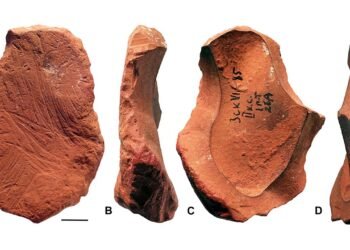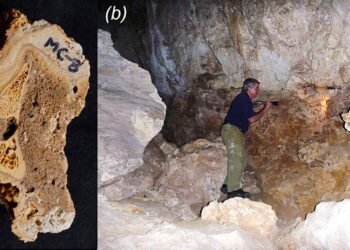Archaeologists have discovered a quartz-paved surface at Piles Hill, located within the expansive Dartmoor region in southwestern England. This exciting find was made during a week-long excavation that involved the collaborative efforts of Dartmoor National Park Archaeologists, Isca Archaeology, and a dedicated team of volunteers.

The excavation, funded by the National Lottery Heritage Fund, Historic England, and the Dartmoor Preservation Association, is part of the “Our Upland Commons” initiative. This initiative is aimed at enhancing our knowledge of upland commons across Dartmoor and similar areas.
The setting for this discovery, Piles Hill, is home to a remarkable double stone row, a monument of considerable historical and ritual significance. Stretching over an impressive 850 meters across Ugborough and Harford Moors, this stone row aligns itself east to west and gently curves upwards, forming a shape akin to a smile.
It is believed to date back to the Neolithic or Early Bronze Age, and it’s comprised of around 40 visible stones. Some of these stones stand upright, while others lie recumbent on the ground, concealed by the surrounding vegetation.
The manner in which the stones lie flat has long intrigued archaeologists and posed questions about whether this positioning was intentional, a result of stones toppling over, or if the monument once had a different alignment. To answer these queries and delve deeper into the mysteries of Piles Hill, the recent excavation was undertaken. To everyone’s surprise, this excavation unveiled yet another enigmatic aspect of Dartmoor’s past—a quartz-paved surface.
The leader of the excavation, National Park Archaeologist Andy Crabb, shared their findings, saying, “As we’d hoped, excavations uncovered large socket holes underneath the ends of the fallen stones, demonstrating that stones once stood upright. This confirmed findings from a geophysical survey last year. But we also made a new discovery. In our last trench, we uncovered a paved cobble-like surface made of angular rocks, consisting predominantly of white quartz. At first, we thought it was the natural geology, but further investigations showed otherwise. We think the rocks were brought to the site and laid there deliberately, possibly to enhance the setting of the stone row.”
The intriguing aspect of this discovery is that the paved path appears to have been intentionally created, potentially to enhance the significance and setting of the stone row. This sheds light on the careful thought and planning that went into the design of such ancient monuments.
This recent discovery of the quartz-paved path at Piles Hill is not unprecedented in the field of Dartmoor archaeology. A similar paved causeway was found at The Hurlers, a prehistoric complex situated on the granite uplands of Bodmin Moor, during an excavation in the 1930s.
The excavation at Piles Hill, conducted in August, has concluded, but post-excavation analysis is ongoing. The team aims to extract precise dating evidence and environmental information from the site samples. Moreover, efforts to secure funding for the restoration of the fallen stones to their original upright positions are underway, potentially making this site an even more prominent and visible scheduled monument.






















